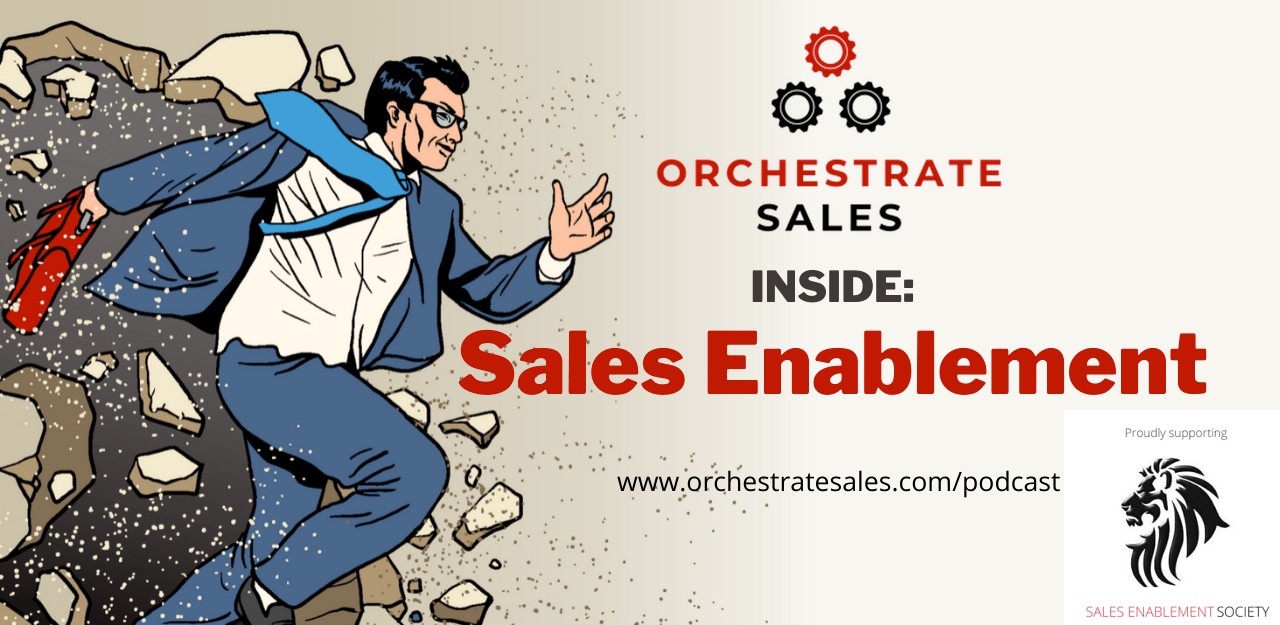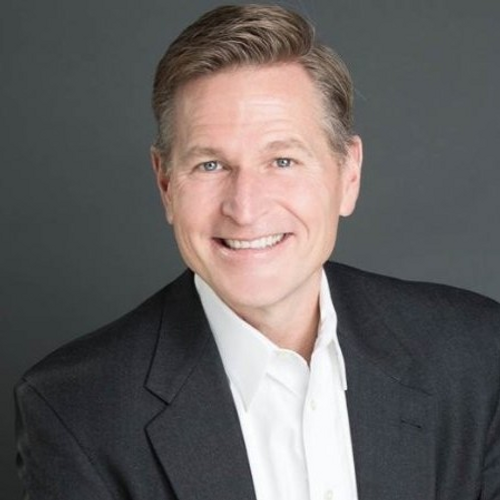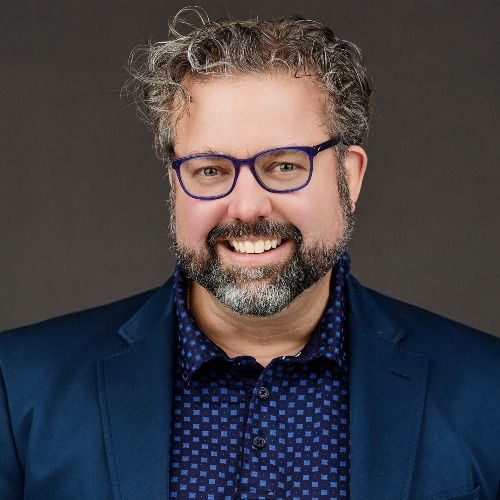Ep25 The Four Flavors / Functions of Sales Enablement
Welcome to the Inside Sales Enablement Podcast, Episode 25
In this episode, we look at Sales Enablement strategically. The sales enablement profession has reached an important pivot point -- and it's likely you need to make some decisions.
While the hype of the role continues to drive more and more hires, many executive leaders are still waiting to see the transformative benefits they expect by making continued investments into enablement.
Most enablement functions start out as the fixer of broken things. Eventually, there is only so much value that can be created that way. You will have to expand your scope and focus on identifying core root problems.
We've been working with leading sales enablement functions for over 10 years. In this podcast, we identify the emerging flavors of sales enablement excellence.
TALENT - Recruit, retain, and develop the right people to help sales leaders be successful with better, more skilled salespeople
MESSAGE - Customer stakeholder specific value-based messages to help sales leaders be successful by helping their salespeople have better and more relevant sales conversations
ENGAGEMENT - Integrated programs to drive pipeline milestones to help sales leaders be successful with more targeted and focused pipeline stimulation programs
ADMINISTRATE - Simplification programs to reduce seller burden by helping sellers spend less time with data entry and more time selling
Join us at https://www.OrchestrateSales.com/podcast/ to collaborate with peers, join Insider Nation, participate in the conversation and be part of the continued elevation of the profession.
EPISODE TRANSCRIPT:
Nick Merinkers 00:02
Welcome to the inside sales enablement podcast. Where has the profession been? Where is it now? And where is it heading? What does it mean to you, your company, other functions, the market? Find out here. Join the founding father of the sales enablement profession Scott Santucci and Trailblazer Brian Lambert as they take you behind the scenes of the birth of an industry, the inside sales enablement podcast starts now.
Scott Santucci 00:34
I'm Scott Santucci.
Brian Lambert 00:35
I'm Brian Lambert and we are the sales enablement insiders. Our podcast is for sales enablement. Leaders looking to elevate their function, expand their sphere of influence, and increase the span of control within their companies.
Scott Santucci 00:48
Together, Brian and I have worked on over 100 different kinds of sales enablement initiatives, ranging from analysts, consultants or even practitioners. We've learned the hard way. What works and most importantly, what doesn't.
Brian Lambert 01:03
And on today's episode, we're going to be talking about the flavors of sales enablement, not how tasty they are Scott, but how they're organized and the scope of sales enablement, as we're out and about and talking to folks. So why don't you frame this out for us.
Scott Santucci 01:21
So normally we have a framing story, but basically ever since October, you and I have been talking to lots of sales enablement, professionals, and sales leaders. And we're developing a kind of two things. One is sort of a clear pocket of where observation about where sales enablement is as a profession. And some of that is frankly very concerning to us. So, what we'd like to do is share with you an observation about sort of tensions and provide some texture about where the role is and then get into the topic of flavors after that, so that people have some context of why we're talking about that. So, Brian, you've recently been, you're just coming back from a trip where you visit a lot of enablement professionals. Let's sort of do the composite of all the different interactions that we've had. Describe for us, what are the characteristics of a sales enablement leader today?
Brian Lambert 02:25
Yeah, sure. And like, like you said, let's look at you know, the last three months so, you know, the end of the year quarter here, and then the beginning of a new year is really the, the timeline that we're looking at. And as you can imagine, Scott, you know, the end of year and start a new year can be pretty busy for sales teams. And, and that's obviously reflecting in the folks that I'm talking to and sales enablement. I don't know if that's also what you're saying, but everybody's busy. So, we'll use the phrase, everybody's busy. And there's there's really two types of busy that I'm seeing There's the busy with activity. And then there's the busy being productive. And that's, that's what I want to talk to our listeners about those are two different things to me. And Scott, I'd love your your take on this. But the idea of being, you know, actively busy is stuff like, Hey, I'm on a plane, I'm responding to requests, I'm running events, people are walking by, and I'm talking to them. I've got a bunch of emails I need to respond to, you know, I'm moving, you know, from meeting to meeting to meeting. I'm attending those, and I'm gathering inputs, and I'm president these, but I'm not necessarily running the meetings. And, you know, I'm thinking about who I need to talk to next, who's coming at me with a request and it's, it's very busy in that stance and a definitely, definitely seeing that on one one continuum on the other continuum. I had some conversations with folks who were also busy, their calendars are pretty, pretty full. But they're setting aside time to talk about, you know, here's what I'm seeing for the 2020 strategy. Here's the focus of the sales team. As as the sales leadership is meeting, this is what I'm, I'm hearing in the meetings across the different sales segments that I support the different sales channels. And you know, what I'm obsessed about and I'm worried about the talk track of my function, and how valuable it is and what its perceived like by these executives. And, you know, I'm not so much that Brian concerned about if I'm, like, I'm concerned about am I considered valuable to the go to market strategy, and I need more numbers, I need more analytics, I need to be able to tell this story better and that's what's keeping me busy in finding the right talent is a secondary, but it's more about, you know, quality of impact, not quantity. So those are the two continuum, everybody's busy but it's like two different types of busy and I've had both of those conversations and they, they couldn't be any more different to bee honest with you. That's what I'm seeing, what about you?
Scott Santucci 05:11
Yeah. So, the way that I would characterize it is it is twofold. I think that there is, on the one hand, there is the I have I have gotten into the role of sales enablement as the head of broken things, right. I'm a powerful person. I have made my name of fixing broken things, the thing that I look for things that are broken, I go to try to fix them. There's so many broken things, I have to go fix it. And you sort of get that mindset of, you know, my team really can't do it. No one else really can do it. I have to just do it. And there's just never enough cycles. There's never enough time in a day. And really, the way I would characterize it is that's being busy because that's what you think you're valuing proposition is the head of broken things. Whereas the flip side is in a role like sales enablement, which is, you know, frankly funnily defined, in even well chartered groups of which we see maybe less than 25%. Brian, I would consider a well chartered function, even those don't nearly have enough time to do all the internal selling required just because the amount of change that's happening in the selling environment and the multitude of different very strong perspectives about what's required to improve sales is it is overwhelming. So, there's the other side of busy which is how do we keep up with all of the demand and all the expectations? That's that would be more how I how I would characterize it sort of bucket number one. I'm busy Most of that's a self-fulfilling prophecy because I believe that my value is because I'm the head of I fix things, I need to be valued, because that's why people value me. That's why we have this department. So, you're always going to be busy. Because that's what you're looking for, you're looking for symptoms to treat, and put them out, put those fires out quickly. Whereas there's the other form of busy, which is maybe you've made maybe you've accomplished something like really standardized on the CPQ price quote system, or maybe you've simplified Salesforce or something like that. There's a lot of maintenance that goes with fixing that. But then what do you do next? But that would be how I could characterize it. Does that map to what you're seeing? Yeah,
Brian Lambert 07:45
yeah. And then to make this, you know, tangible for folks there's, you know, in the busy of attending the meetings versus the busy of heading the meetings and calling the meetings and organizing the cross functional team to fix something. You know, I think that's a good litmus test on how many meetings are you really running? What are you really controlling in that type of busy is completely different just to bring that home at a individual level? And then Scott, you know, as we lead into our topic for today, you know, we've talked about this. And we're seeing these these patterns develop of where sales enablement teams and are spending their time and what types of initiatives they're running, for example, some might be focused on messaging are where I spent a lot of time on the people and performance and training side of sales enablement. And you've developed over time, a lot of understanding of this type of scope. And, you know, we've been talking about these areas, which we were calling flavors of sales enablement. They'd be great to walk through that can you can you share the framework?
Scott Santucci 09:01
Sure. So, what it is it's it's a observational framework backed by a lot of practical, practical experience. And what it really comes down to is, if you are we delineated the two types, right? type number one is, hey, I am valuable because I get stuff done. And that's, that's the premise of my department. What I'm about to talk to you, you're probably going to reject everything, you're going to say this sounds too theoretical. What's my action? And, you know, frankly, what am I going to ask you to do is think about is it is fixing symptoms really valuable? Or is creating is elevating your function and create and actually proactively addressing the source of the symptoms is that's what's valuable. Yeah, that's really the second bucket. Right.
Brian Lambert 09:55
And I just wanted to quickly that's great point. There's there's what How everybody shows up to you as a sales enablement leader, let's park that and what people are asking for and what they're bombarding you with. And well, what are the inputs? I let's just, let's just talk about you and your role. And what is what is your value? What do you what do you think you should be? What do you need to be as a functional leader? And, you know, I like that dichotomy, Scott of are you fixing the broken things? Or are you doing something different? And that's regardless of how people are showing up to you right now in this conversation.
Scott Santucci 10:30
Yeah. And I think that the best way to, you know, park that right to create the space of it. I love this quote from Henry Ford. If I would ask customers what they want. They want a faster horse. It you have so much inbound demand about what you should be doing. If you just take that all on. You're just making faster horses instead of cars, right. So, let's make that pivot. And let's recognize that the full scope of all of this Things that sales enablement could touch is so galactically huge. We could look at this and say, sales is about driving revenue or bookings. And enablement is about doing anything to make that make that easier. So, with that scope with that huge, gigantic scope, we're basically talking about a function that is the connective tissue of all of the different silos inside the company. Obviously, that scope is too gigantic for any one group to really tackle. But you have to be able to move outside of, hey, our sales kickoff stinks. We need to have somebody just had better sales, kickoffs, let's tap you on the shoulder to go fix it. So, there's a balance between the two. So, what we've identified is there's four big chunks that you can fix that really go around fixing friction that exists among the sales organization and different functional groups. And that's really where a lot of these problems exist in the first place. Because customers don't really care about your organizational politics and you know, who reports to who they care about getting the answers. So, what we're going to do is we're going to walk through these four, we're going to do it one at a time. All right. Does that make sense?
Brian Lambert 12:30
Yeah, I like it.
Scott Santucci 12:31
Okay. So, the first function, the first chunk, of that big giant area is the chunk around talent. That talent you can look at and a lot of different ways. But let's just first talk about all of the different activities, or things that are involved in talent. Talent starts with hiring. So, the whole process of figuring out what kind of stuff Sales Rep do we need in the first place? To how do we go and recruit them or pay for them? All of that stuff all the way through to evaluating and, you know, improving reps. There's a whole lot that goes into talent. And then when you think about all the stuff that goes into talent, let's talk about all the functions involved. Finances involved because they have to improve approve the headcount in the first place. Different groups within HR involved from from the jeez every HR group is organized differently, but you have some basic functions like leadership development, you're gonna have sort of performance, HR performance people, you're gonna have recruiters and your l&d department might work in your your human resources group. Each one of those departments may or may not interact with each other. Then when you go to the sales organization Who's the primary interface point? Who's the primary interface point from the on taking? The, you know, how are we going to make requests of new hires? Is that an individual sales manager that does that get funneled through through sales operations? What role does sales enablement play in terms of, hey, we've got this amount of inbound calls, do you have foresight into onboarding? And when does onboarding begin and end? There's a whole slew of things under talent. So, the way that we like to look at talent is it's the process of recruiting, retaining, and developing the right people. That's sort of the scope of it. There are many different departments involved, the benefit to salespeople are better and more skilled reps and improvement. And we look at that as a business process from hire to retire. So that's, that's really the first bucket.
Brian Lambert 14:56
Yeah, like that. And you know, you talked about functions. And some of the titles that I've seen in there are, indeed, you know, l&d. I've seen sales enablement, have that title of sales enablement, but the scope is around the talent piece. And in the talent piece, they're really focused on, for example, just the onboarding slice. And so, there's an opportunity there to expand if you are in the talent piece, or flavor to think about, you know, how do you branch into recruiting and then also the ongoing development area to really improve the the, you know, the rep experience from hired through retire?
Scott Santucci 15:38
Yeah, so I think what we can do is we can zoom in and have a show on each one of the flavors to provide more context. But really, what we want to highlight would be the scope of what you're looking for, and who are the departments or the stakeholders whom you need to work with. What is the business process that this this would entail so that you can manufacture something and Produce sustainable results? And then what is the measurable impact on the sales organization?
Brian Lambert 16:06
Great. Let's go to the next flavor.
Scott Santucci 16:09
Okay, so the next flavor is really about the friction that exists between marketing and sales. And I personally do not like marketing and sales alignment that sounds like we're going to get a bunch of guitars together hold hands and sing Kumbaya. It is beyond alignment, it must be integrated. And so, what we're what we're looking at is let's think about it this way. If we get our talent, right, let's say that we develop the best course ever. We've got the most skilled reps in the entire industry. When they show up, they still have to talk about something. Right, that message of what they talk about, doesn't come from training. It comes from the synthesis of information from individual product Marketers. You might have solution experts, you might have vertical overlays. Think about all of the people in different departments that have a variety of subject matter expertise, and strong opinions about how to take your company's messaging and positioning and making it relevant to the individual human beings that salespeople engage with. So, we call this bucket or flavor message. And in message, it's about translating all of the stuff about your company into conversational specific things. And the business process that we look at it is concept to contact. And what that means really is when you go when we go and talk to a lot of customers, one of the things that are people like you, I really like to ask so you know, what do we sell? Who do we sell to? And why do they buy? And to me, those are the elements everybody should know those answers, but very few companies can give me consistent answers. And where they stumble the most is the who they give me personas. But personas aren't good enough. We need to be a salesperson must find somebody with an altitude level and a leadership position to drive a new thing forward. They have to have the right access to budgets or, you know, the ability to assemble budgets. And they have to have the right you know, sort of confidence level to be able to do this because let's face it, we're introducing something new into these into these clients. And there's a big change management component that is risky to most to most people. So really, what we're talking about here is how do you orchestrate all that messaging and move it away from being product focused, and to be make it more success or outcome I have major major transformation.
Brian Lambert 19:02
Absolutely. And that you get, you know, when you do that the fuel for customer conversations. And, you know, there there are multiple roles in the organization that benefit from that not, you know, there's sales and there's also customer service and solution architects, etc. So, there's a lot of stakeholders involved in that. And if you are in the talent space as a listener, and you're like, Well, you know, that's outside my scope, that's fine. The question I would also then ask or just think about is, are we still talking




